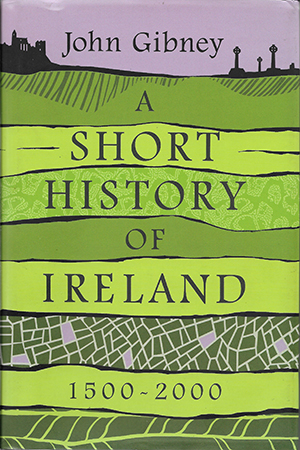A SHORT HISTORY OF IRELAND 1500–2000
Published in Book Reviews, Book Reviews, Issue 4 (July/August 2019), Reviews, Volume 27JOHN GIBNEY
Yale University Press
$25
ISBN 9780300208511
Reviewed by Evan Comerford
 With an MA in Irish History from Maynooth University, Evan Comerford is a civil servant with the Department of Agriculture, Food and the Marine.
With an MA in Irish History from Maynooth University, Evan Comerford is a civil servant with the Department of Agriculture, Food and the Marine.
‘Certainly, even if history were judged incapable of other uses, its entertainment value would remain in its favour.’ So wrote the French historian Marc Bloch while he lay in a prisoner-of-war camp during the Second World War. Even then he was able to surmise how the popularity of history books relied on the curious nature of human beings and not in their educational value alone. The way history itself is written develops over time and is often a product of its own context and surroundings, a process which has undoubtedly been assisted by the current decade of commemorations. For that reason, books like John Gibney’s will constantly find their way into bookshops. Despite the proliferation of similar texts in the past, an accessible and succinct synopsis of modern Irish history continues to be a welcome addition to Irish historiography. The more interesting question is: how does an author say something new?
The structure of this book contributes to its accessibility. It follows a simple, chronological pattern through the main historical events of the period, interwoven with a discussion of their context and impact. Justification of the time-line under examination is always a fiercely scrutinised aspect of any history book and Gibney freely admits from the outset that 1500 is more convenient in terms of European history, aligning with the development of the printing press, the Renaissance and the Reformation. From an Irish perspective, the story really starts in the 1530s and 1540s as Ireland’s relationship with our nearest neighbours comes into focus.
The book is neatly divided into five parts, each focusing on one of the five centuries under study, with several sub-chapters tackling the notable events of that century. An interesting addition to each section is a chapter entitled ‘Where Historians Disagree’. Here Gibney capably summarises the wider debates and recent work in the research field, which is an invaluable resource to the student of Irish history. To that end, the evidence quoted throughout the book relies almost entirely on the most recent or significant work of other historians. Nevertheless, it doesn’t hide the author’s obvious expertise and knowledge of the vital primary sources that have informed his narrative. The writing style is informative and eschews any colourful expressions of opinion. Gibney moves briskly through the narrative of events without being dismissive or dehumanising aspects of the story. He stays away from sweeping conclusive statements and keeps the bulk of his analysis embedded within the flowing text.
Gibney’s take on the sixteenth and seventeenth centuries is one of the strong points of the book. This period is often misunderstood and less popular than the romantic revolutionary era. His descriptions of the power dynamics between the native Irish, Old English and New English planters in the early chapters establishes a clear image of the ruling environment, which is underpinned by a narrative that emphasises their nuanced interdependent relationships. He references and acknowledges the clash of cultures between the planters and natives during the Ulster Plantation. Equally, he is happy to toss in a curveball and state that the English planters commonly learned the native language as a practical means of communication with the Gaelic Irish. He stresses the slow emergence of an Irish Catholic identity in the seventeenth century against the backdrop of a strengthening Protestant regime, one that made no distinction between Gaelic Irish and Old English. Such balanced treatments help to clarify the modern mistaken assumption that being an Irish nationalist has always been synonymous with being an Irish Catholic, while also clarifying that the definition of Irish nationalism in 1798 differed greatly to that of 1916.
A short history of Ireland is in ways a modern remake of the classic Irish history text, in the sense that it doesn’t stray too far from the high political narrative of symbolic figures and events like the Act of Union and the Land War as the basis for explaining the past. The chapters on the eighteenth and nineteenth centuries are dominated by the consolidation of wealth by the Protestant Ascendancy and their desire to see Ireland recognised as a kingdom of commensurate status with their English counterpart. Daniel O’Connell’s achievements and the impact of the Great Famine are handled within the context of political manoeuvring and the actions or failings of government, rather than through a more robust discussion of their wider societal implications. Emigration and the Irish diaspora are discussed, but not at a level of detail that does justice to their impact on the demographic landscape. Social history continues to rank below the narrative of high politics when it comes to the general history text such as this.
This book is more than just a suitable gift for an Irish history novice; it is in-depth enough to offer readers with previous knowledge a chance to revisit and learn more. It’s an example of how the writing of Irish history has matured into nuanced, source-based analysis in place of polarised judgements.
















